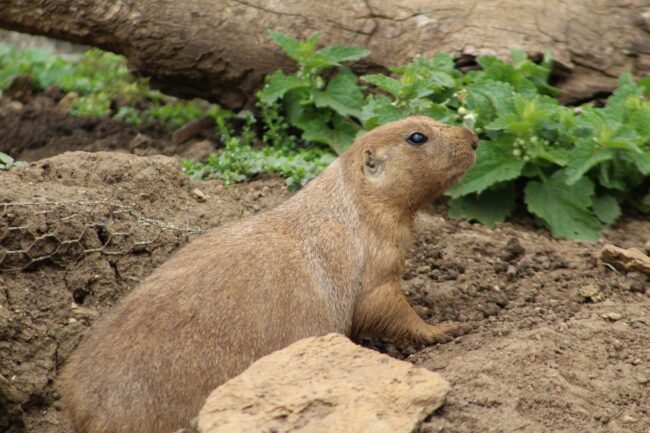Table of Contents
Looking to chase away your groundhog problem with the help of a friendly predator? Or just curious about its place in the food chain? Either way, you come to the right place to learn more about which animals in nature are natural predators of groundhogs.
These rodents are abundant, which might give the false impression that not many creatures prey on them. However, groundhogs have several main predators and we will many of these in the article. But first, let’s get to know our groundhog friends a little better!
A Guide to Groundhogs
So, what do we need to know about these whistle pigs? Here we briefly talk about their appearance, dietary habits, habitat, life cycle, and distribution before moving on to see which predators control their numbers.
1. What do they look like?
They are the biggest members of the squirrel family. They have solid, squat legs, and a grizzled, dim earthy-colored hide that helps keep them warm in winter. They also have small ears, a short, shaggy tail, and sharp, bent claws that allow them to dig successfully into the earth.
Although they can be as short as 40 to 60 centimeters, they are among the world’s heaviest rodents with an average weight of around 4 kilograms. Their most interesting feature, however, is their chisel-like teeth that never stop growing!
2. Food and Diet
Groundhogs are notorious for binge-eating lots of vegetables every day. This makes them a considerable threat to vegetable gardens. Mainly vegetarian, groundhogs depend on a plant-based diet, gorging on everything from apples, carrots, and nursery veggies to blossoms, dandelions, and even tree husk.
They eat plants like alfalfa and clover, as well as leaves and bird eggs. They also love raspberries, blackberries, and cherries and even eat grasshoppers, June bugs, and other large insects. Groundhogs stock up on as much food as they can in the spring and summer to build up fat reserves for their hibernation in the winter.
While eating, a groundhog is careful to be on the lookout for predators. It usually feeds close to one of its burrow openings, so it can easily scurry back inside in case of danger.
3. Habitat and Distribution
A lowland creature of North America, it is abundantly found throughout the eastern United States, across Canada, and into Alaska.
Naturally found in open fields, pastures, and meadows near lush, wooded shrubberies, they also regularly advanced into households’ gardens and backyards. They generally reside in forests and woods where they feed on small prey and plants and easily create burrows in the soft muddy floor of these regions.
4. Burrows
As extensive tunnelers, these animals use their claws to dig complex and multi-chambered underground tunnels. These hidden passages can run up to 25 feet long and sport 2 to 3 entrances.
They normally burrow by moving almost one cubic meter of mud. You can spot the main entrance of the burrow by the pile of this mud next to it, which they use for observation purposes. Their burrows are used for sleeping, protection, hibernation, and as a place to raise their pups.
5. Life Cycle
In their natural setting, woodchucks live an average of two to three years, sometimes going up to six. In confinement, on the other hand, they have been reported to live for as long as 14 years.
Their mating season is early in the spring and, after a short, month-long pregnancy, female groundhogs give birth to a litter of two to six pups. Young groundhogs are known as kits, pups, or even chucklings. They reach sexual maturity in two years.
Woodchuck’s Place in the Food Chain
Now we will take a look at the groundhog’s prime predators. We will also learn woodchucks defend themselves against attacks
Primary Predators
Predators of groundhogs in the wild include badgers, coyotes, foxes, and bobcats. Most of these predators hunt with exceptional stealth and silence, which allows them to catch their prey by surprise. Badgers, on the other hand, retrieve them from their underground homes by digging.
Other sizable predators like the eastern cougar and gray wolf are close to local extinction in some eastern parts but they still hunt groundhogs occasionally in Canada. Golden eagles also feed on full-grown groundhogs but are rarely found in the same habitats as them. Similarly, great horned owls can hunt woodchucks but don’t often do it because of the time difference in their active hours.
Young groundhogs, particularly those under two months old, are often preyed upon by American minks, among other small mustelids, timber rattlesnakes, hawks, and cats. Red-tailed hawks and northern goshawks also take smaller and younger groundhogs.
Survival Strategies
Always wary of predators, groundhogs design their burrows to keep intruders from entering. If the predator still manages to enter, the groundhogs fight back and defend themselves using their curved claws and sharp incisors.
Even with their stocky body type, they are excellent climbers and swimmers. This equips them to find refuge from potential hunters with speed and ease.
Upon spotting a predator, they are also quick to alert other groundhogs by generating a high-pitched whistling sound. This gave them their popular nickname of “whistle pig.”
A Quick Summary
Groundhogs have many predators. This could be one of the reasons why their lifespan is relatively short in the wild but much longer in captivity. Groundhogs are adept, however, at detecting, escaping, and even warning other woodchucks against predators.

